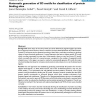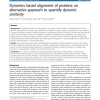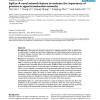148 search results - page 14 / 30 » The evolutionary capacity of protein structures |
BMCBI
2007
13 years 7 months ago
2007
Background: Since many of the new protein structures delivered by high-throughput processes do not have any known function, there is a need for structure-based prediction of prote...
BMCBI
2010
13 years 2 months ago
2010
Background: The dynamic motions of many proteins are central to their function. It therefore follows that the dynamic requirements of a protein are evolutionary constrained. In or...
BMCBI
2006
13 years 7 months ago
2006
Background: Measuring each protein's importance in signaling networks helps to identify the crucial proteins in a cellular process, find the fragile portion of the biology sy...
BIOCOMP
2009
13 years 8 months ago
2009
Abstract-- Stating protein design as an energy minimization in the space of amino acid sequences and rotamer combinations is usual. In the current paper an evolutionary algorithm b...
ICASSP
2007
IEEE
14 years 1 months ago
2007
IEEE
Protein structure prediction aims to determine the three-dimensional structure of proteins form their amino acid sequences. When a protein does not have similarity (homology) to a...



